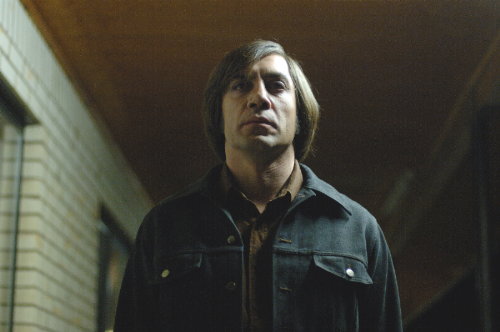
In Oprah-approved author Cormac McCarthy’s 2005 novel No Country For Old Men, an aging small town Texas sheriff ruminates about the scary new world he finds himself living in, complete with new crimes committed by new breeds of criminals he’s unsure if he’s able to face.
Meanwhile, good old boy Llewelyn Moss finds a satchel full of millions of dollars in the midst of a cross-the-border drug deal-turned-Mexican standoff gone very wrong, and takes it—a move sure to sic the money’s rightful owners on him.
What follows is a three-way chase, with Llewelyn on the run with the money, a mysterious, unstoppable killer on trail, and the law pursuing them both. It’s a pretty simple, even shallow story, but McCarthy’s a subtle talent, and he fills seemingly negative story space with implied meaning and dramatic import in a way that gradually catches up with the reader.
The author’s trademark spare storytelling and hands-off approach to visuals and world-building—character descriptions never go any farther than maybe hair or eye color in this particular book, and almost everything but the dialogue and plot are left to the readers’ imagination—provides a perfect vacuum for filmmakers to fill, particularly when the filmmakers have the sort of quirky talents that have made the Coen Brothers’ body of work so distinctive.
The brothers follow McCarthy’s novel as faithfully as possible, making precious few changes. Most of those seem to be made to allow for the transfer to a different medium (The sheriff’s first-person narration scenes, for example, are cut up and placed into conversations with other characters), although a few serve to ratchet up tension.
There’s still plenty of room to inject themselves and their style into the narrative, however. The visual component so absent from the prose is filled in with relish, as the Coens and cinematographer Roger Deakins capture the desolate Texas deserts and highways in the film’s opening sections, before gradually building a nighttime world of pitch black wilderness, drive-up motels and eerily empty streets.
Their cast is full of real character-characters, as the best Coen movies usually are, each brought to life through a combination of charismatic performance and eccentric costuming.
Josh Brolin plays Moss, a stoic, silent everyman type who’s hard to read behind his moustache. Those pursuing him include Javier Bardem as hired psycho killer Anton Chigurh, a black clad elemental force who wears his hair like a mop-top Beatle and carries a pneumatic cow slaughtering device with him everywhere he goes; Tommy Lee Jones as the craggy-faced sheriff trying to make sense of the escalating body count while trading police procedural witticisms with his deputy; and Woody Harrelson as a cocky bounty hunter-hunter in grays and powder blues.
Of the characters, the Coens seem to have the most in common with Bardem’s Chigurh, in terms of brutal efficiency and unique delivery. The outcome of the film, and the ends of many of the characters, seems somewhat certain from rather early on, which rather than spoiling actually increases the tension—doom is surely coming, but its time and method are unknown.
The Coens, like McCarthy, constantly subvert expectations, as the story doesn’t play quite like you’d come to expect such narratives to from too much time spent at the movies.
While almost every word of dialogue is pulled right out of the book—the alterations are all a matter of subtraction rather than addition—the film is a hell of a lot funnier, because of the sort of delivery the characters bring to them. Bardem’s weird pronunciation and aggressive way with words, or Jones’ folksy resignation bring the occasional laugh line, making for the sort of black humor so often associated with the Coens.
It’s worth noting that here, it’s almost always a case of nervous laughter. As Jones’ sheriff says to his deputy, who inadvertently laughs out loud after told about a senior citizen murder ring, sometimes you just got to laugh at this stuff, as it’s all you can do.

